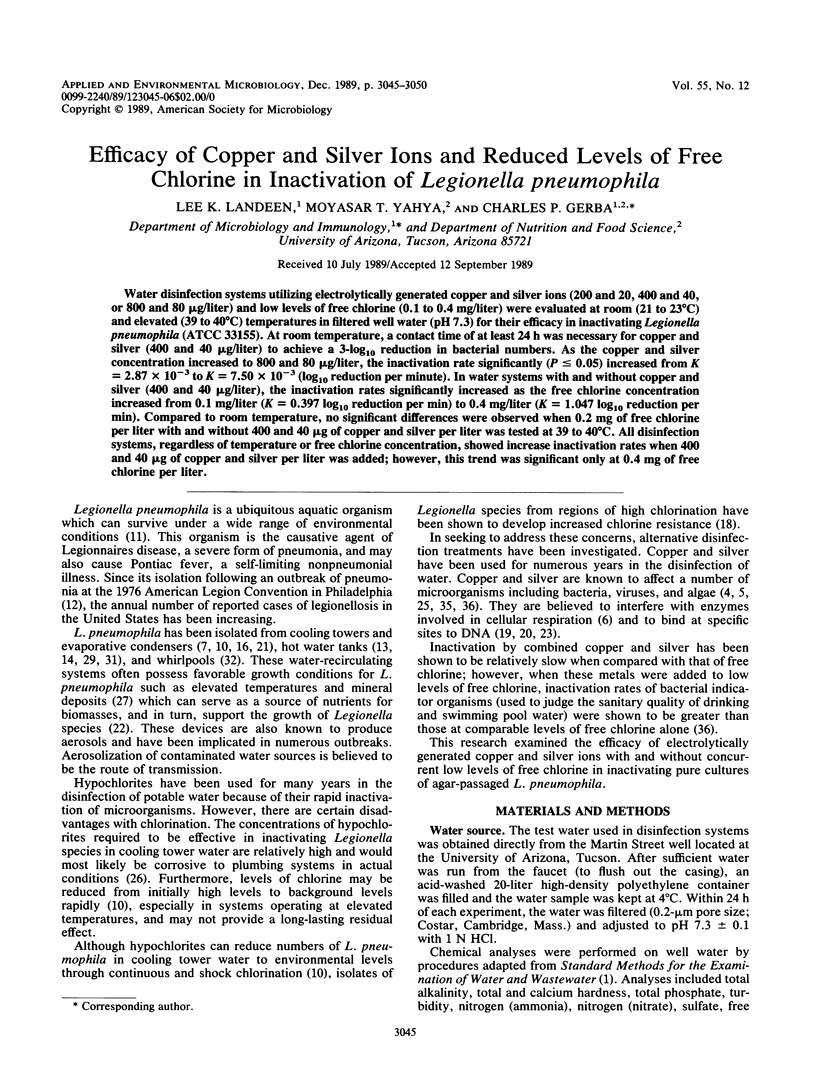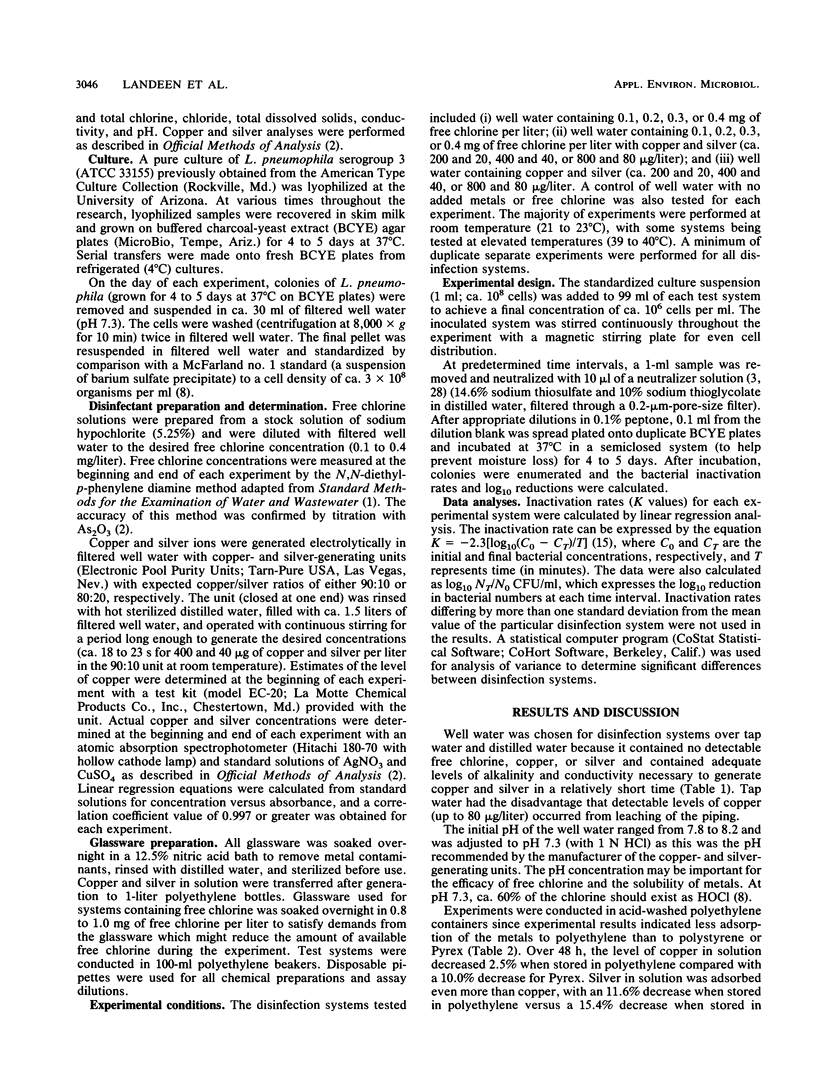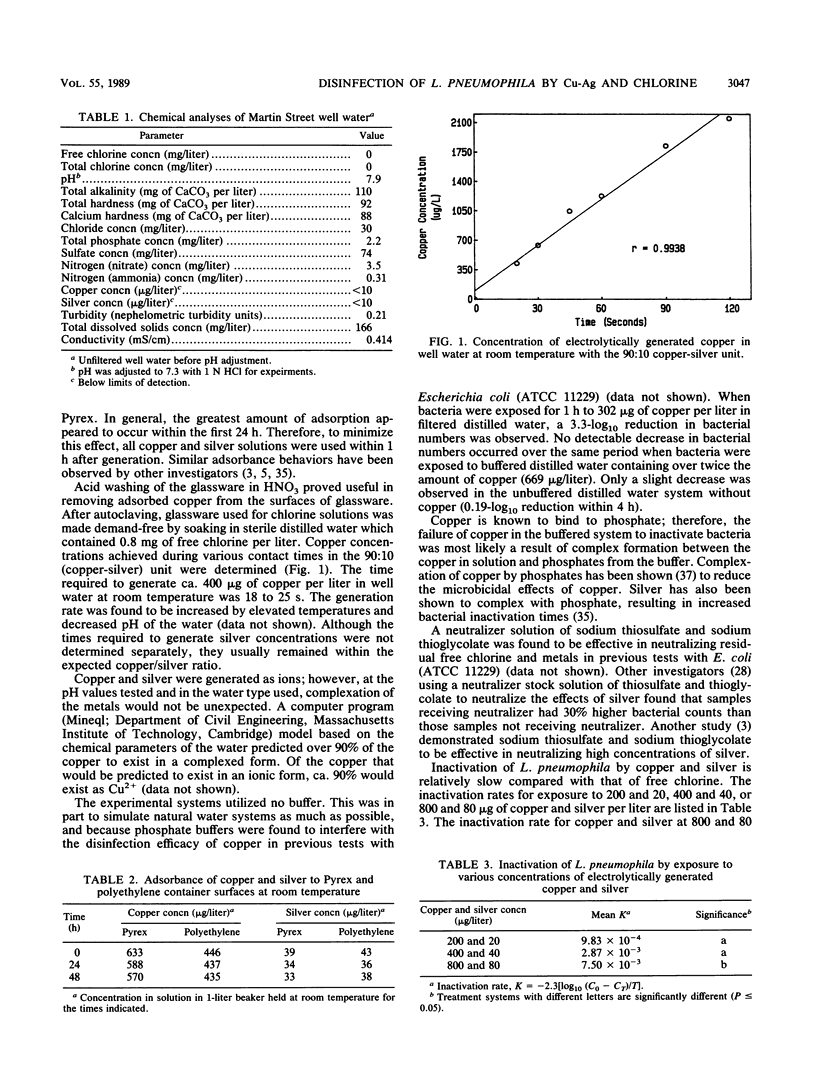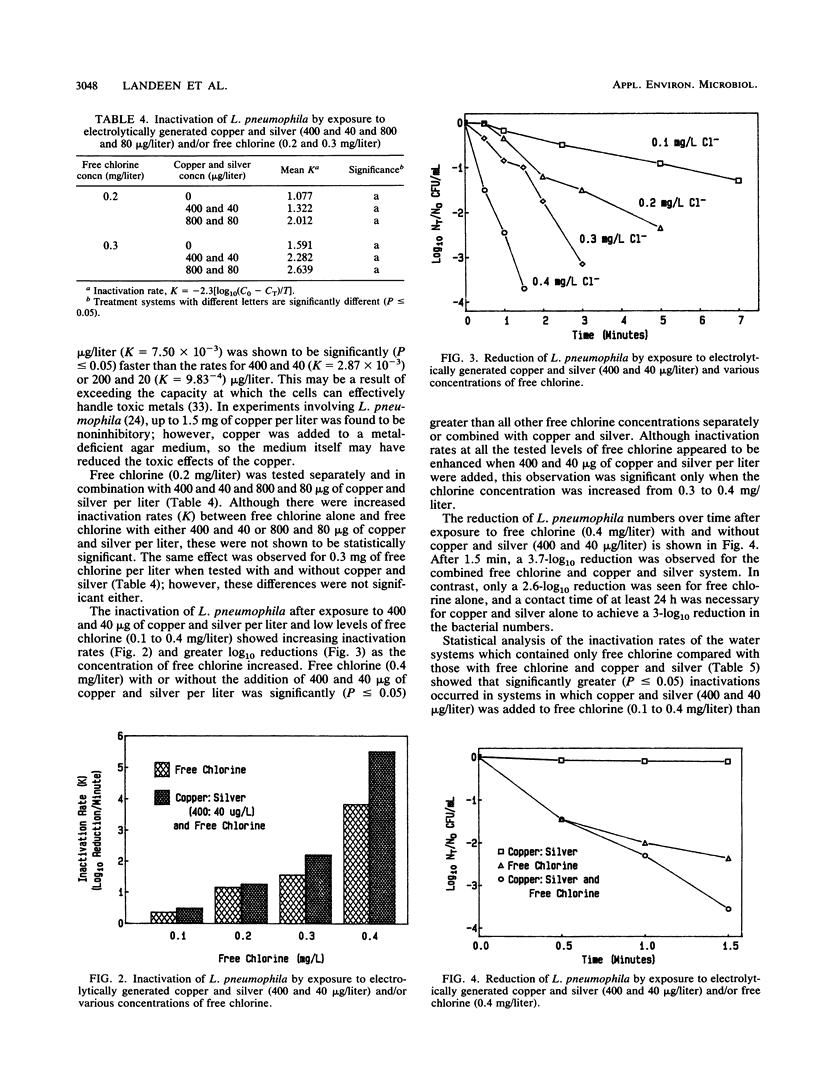Abstract
Water disinfection systems utilizing electrolytically generated copper and silver ions (200 and 20, 400 and 40, or 800 and 80 micrograms/liter) and low levels of free chlorine (0.1 to 0.4 mg/liter) were evaluated at room (21 to 23 degrees C) and elevated (39 to 40 degrees C) temperatures in filtered well water (pH 7.3) for their efficacy in inactivating Legionella pneumophila (ATCC 33155). At room temperature, a contact time of at least 24 h was necessary for copper and silver (400 and 40 micrograms/liter) to achieve a 3-log10 reduction in bacterial numbers. As the copper and silver concentration increased to 800 and 80 micrograms/liter, the inactivation rate significantly (P less than or equal to 0.05) increased from K = 2.87 x 10(-3) to K = 7.50 x 10(-3) (log10 reduction per minute). In water systems with and without copper and silver (400 and 40 micrograms/liter), the inactivation rates significantly increased as the free chlorine concentration increased from 0.1 mg/liter (K = 0.397 log10 reduction per min) to 0.4 mg/liter (K = 1.047 log10 reduction per min). Compared to room temperature, no significant differences were observed when 0.2 mg of free chlorine per liter with and without 400 and 40 micrograms of copper and silver per liter was tested at 39 to 40 degrees C. All disinfection systems, regardless of temperature or free chlorine concentration, showed increase inactivation rates when 400 and 40 micrograms of copper and silver per liter was added; however, this trend was significant only at 0.4 mg of free chlorine per liter.
Full text
PDF





Selected References
These references are in PubMed. This may not be the complete list of references from this article.
- Domek M. J., LeChevallier M. W., Cameron S. C., McFeters G. A. Evidence for the role of copper in the injury process of coliform bacteria in drinking water. Appl Environ Microbiol. 1984 Aug;48(2):289–293. doi: 10.1128/aem.48.2.289-293.1984. [DOI] [PMC free article] [PubMed] [Google Scholar]
- Dondero T. J., Jr, Rendtorff R. C., Mallison G. F., Weeks R. M., Levy J. S., Wong E. W., Schaffner W. An outbreak of Legionnaires' disease associated with a contaminated air-conditioning cooling tower. N Engl J Med. 1980 Feb 14;302(7):365–370. doi: 10.1056/NEJM198002143020703. [DOI] [PubMed] [Google Scholar]
- Fliermans C. B., Cherry W. B., Orrison L. H., Smith S. J., Tison D. L., Pope D. H. Ecological distribution of Legionella pneumophila. Appl Environ Microbiol. 1981 Jan;41(1):9–16. doi: 10.1128/aem.41.1.9-16.1981. [DOI] [PMC free article] [PubMed] [Google Scholar]
- Fraser D. W., Tsai T. R., Orenstein W., Parkin W. E., Beecham H. J., Sharrar R. G., Harris J., Mallison G. F., Martin S. M., McDade J. E. Legionnaires' disease: description of an epidemic of pneumonia. N Engl J Med. 1977 Dec 1;297(22):1189–1197. doi: 10.1056/NEJM197712012972201. [DOI] [PubMed] [Google Scholar]
- Habicht W., Müller H. E. Occurrence and parameters of frequency of Legionella in warm water systems of hospitals and hotels in Lower Saxony. Zentralbl Bakteriol Mikrobiol Hyg B. 1988 Mar;186(1):79–88. [PubMed] [Google Scholar]
- Helms C. M., Massanari R. M., Zeitler R., Streed S., Gilchrist M. J., Hall N., Hausler W. J., Jr, Sywassink J., Johnson W., Wintermeyer L. Legionnaires' disease associated with a hospital water system: a cluster of 24 nosocomial cases. Ann Intern Med. 1983 Aug;99(2):172–178. doi: 10.7326/0003-4819-99-2-172. [DOI] [PubMed] [Google Scholar]
- Kuchta J. M., States S. J., McNamara A. M., Wadowsky R. M., Yee R. B. Susceptibility of Legionella pneumophila to chlorine in tap water. Appl Environ Microbiol. 1983 Nov;46(5):1134–1139. doi: 10.1128/aem.46.5.1134-1139.1983. [DOI] [PMC free article] [PubMed] [Google Scholar]
- Kurtz J. B., Bartlett C. L., Newton U. A., White R. A., Jones N. L. Legionella pneumophila in cooling water systems. Report of a survey of cooling towers in London and a pilot trial of selected biocides. J Hyg (Lond) 1982 Jun;88(3):369–381. doi: 10.1017/s0022172400070248. [DOI] [PMC free article] [PubMed] [Google Scholar]
- Liebe D. C., Stuehr J. E. Copper(II)-DNA denaturation. I. Concentration dependence of melting temperature and terminal relaxation time. Biopolymers. 1972 Jan;11(1):145–166. doi: 10.1002/bip.1972.360110112. [DOI] [PubMed] [Google Scholar]
- Liebe D. C., Stuehr J. E. Copper(II)-DNA denaturation. II. The model of DNA denaturation. Biopolymers. 1972 Jan;11(1):167–184. doi: 10.1002/bip.1972.360110113. [DOI] [PubMed] [Google Scholar]
- Morris G. K., Patton C. M., Feeley J. C., Johnson S. E., Gorman G., Martin W. T., Skaliy P., Mallison G. F., Politi B. D., Mackel D. C. Isolation of the Legionnaires' disease bacterium from environmental samples. Ann Intern Med. 1979 Apr;90(4):664–666. doi: 10.7326/0003-4819-90-4-664. [DOI] [PubMed] [Google Scholar]
- Rahn R. O., Setlow J. K., Landry L. C. Ultraviolet irradiation of nucleic acids complexed with heavy atoms. 3. Influence of Ag+ and Hg2+ on the sensitivity of phage and of transforming DNA to ultraviolet radiation. Photochem Photobiol. 1973 Jul;18(1):39–41. doi: 10.1111/j.1751-1097.1973.tb06390.x. [DOI] [PubMed] [Google Scholar]
- Reeves M. W., Pine L., Hutner S. H., George J. R., Harrell W. K. Metal requirements of Legionella pneumophila. J Clin Microbiol. 1981 Apr;13(4):688–695. doi: 10.1128/jcm.13.4.688-695.1981. [DOI] [PMC free article] [PubMed] [Google Scholar]
- Singh A., McFeters G. A. Survival and virulence of copper- and chlorine-stressed Yersinia enterocolitica in experimentally infected mice. Appl Environ Microbiol. 1987 Aug;53(8):1768–1774. doi: 10.1128/aem.53.8.1768-1774.1987. [DOI] [PMC free article] [PubMed] [Google Scholar]
- Skaliy P., Thompson T. A., Gorman G. W., Morris G. K., McEachern H. V., Mackel D. C. Laboratory studies of disinfectants against Legionella pneumophila. Appl Environ Microbiol. 1980 Oct;40(4):697–700. doi: 10.1128/aem.40.4.697-700.1980. [DOI] [PMC free article] [PubMed] [Google Scholar]
- Stout J. E., Yu V. L., Best M. G. Ecology of Legionella pneumophila within water distribution systems. Appl Environ Microbiol. 1985 Jan;49(1):221–228. doi: 10.1128/aem.49.1.221-228.1985. [DOI] [PMC free article] [PubMed] [Google Scholar]
- Tilton R. C., Rosenberg B. Reversal of the silver inhibition of microorganisms by agar. Appl Environ Microbiol. 1978 Jun;35(6):1116–1120. doi: 10.1128/aem.35.6.1116-1120.1978. [DOI] [PMC free article] [PubMed] [Google Scholar]
- Tobin J. O., Swann R. A., Bartlett C. L. Isolation of Legionella pneumophila from water systems: methods and preliminary results. Br Med J (Clin Res Ed) 1981 Feb 14;282(6263):515–517. doi: 10.1136/bmj.282.6263.515. [DOI] [PMC free article] [PubMed] [Google Scholar]
- Wadowsky R. M., Yee R. B., Mezmar L., Wing E. J., Dowling J. N. Hot water systems as sources of Legionella pneumophila in hospital and nonhospital plumbing fixtures. Appl Environ Microbiol. 1982 May;43(5):1104–1110. doi: 10.1128/aem.43.5.1104-1110.1982. [DOI] [PMC free article] [PubMed] [Google Scholar]


